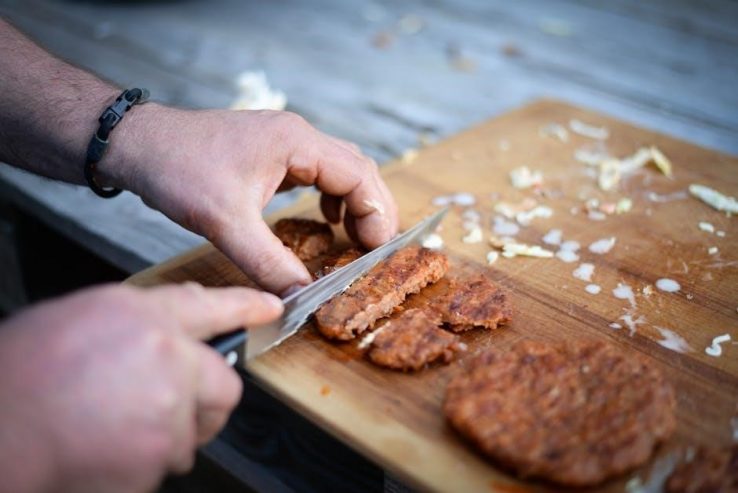Beef cutting instructions guide you in personalizing your meat orders‚ ensuring desired cuts like steaks‚ roasts‚ or ground beef‚ with expert butchers handling the precise preparation.
Understanding the Basics of Beef Cutting
Understanding the basics of beef cutting involves knowing how to break down a whole beef into primal cuts and retail cuts. Front and hind quarters differ in fat content and muscle structure‚ affecting flavor and tenderness. Primal cuts like chuck‚ rib‚ and sirloin are divided into retail cuts such as steaks‚ roasts‚ or ground beef. Factors like steak thickness‚ roast size‚ and grind coarseness are crucial for desired results. Proper cutting techniques ensure even cooking and optimal flavor. Communication with your butcher is key to specifying preferences‚ whether for slow-cooking cuts or lean ground beef. This foundational knowledge helps personalize your beef order to suit your cooking needs and preferences effectively.
Importance of Proper Cutting Techniques
Proper beef cutting techniques are essential for achieving optimal flavor‚ tenderness‚ and visual appeal. Correct cuts ensure even cooking‚ preventing undercooked or overcooked areas. Precise trimming and portioning reduce waste and maximize the value of your beef. Proper techniques also enhance food safety by removing contaminants and ensuring uniform thickness for consistent cooking. Butchers rely on clear instructions to meet your preferences‚ whether for thick steaks‚ lean roasts‚ or finely ground beef. Accurate cutting preserves the natural quality of the meat‚ ensuring a superior dining experience. By guiding the butcher effectively‚ you can enjoy perfectly prepared beef tailored to your culinary needs and cooking methods.
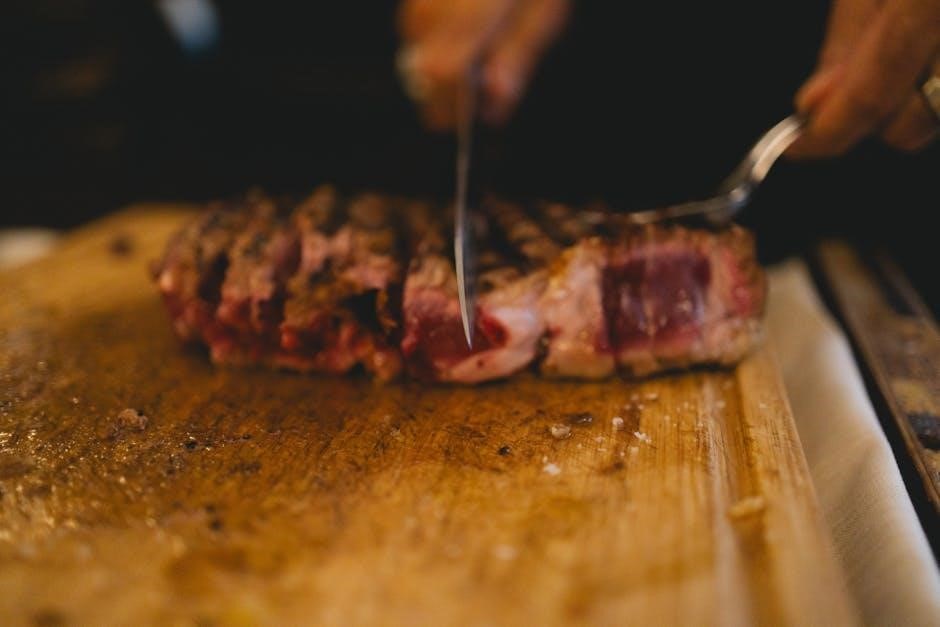
Tools and Equipment Needed for Beef Cutting
Essential tools include sturdy knives‚ meat saws‚ and cutting boards. Safety gear like gloves and aprons is crucial for protecting yourself while handling and cutting beef effectively.
Essential Knives for Beef Preparation
Beef preparation requires specific knives for precision and efficiency. A cleaver is ideal for splitting bones and cutting through large sections. The boning knife excels at trimming fat and removing bones from primal cuts. A fillet knife‚ with its flexible blade‚ is perfect for slicing thin cuts like flank steak. The chef’s knife handles general tasks‚ such as chopping and mincing. Lastly‚ a slicing knife ensures even‚ thin cuts for steaks and roasts. Each knife serves a unique purpose‚ making them indispensable for achieving professional results in beef cutting and preparation.
Meat Saws and Cutting Surfaces
Meat saws and cutting surfaces are crucial for efficient beef preparation. A meat saw is essential for cutting through bones and dividing large primal cuts into manageable sections. Choose between a manual saw for precision or an electric saw for faster processing. A sturdy cutting surface‚ such as a wooden or plastic butcher block‚ provides a sanitary and durable workspace. For optimal hygiene‚ opt for a stainless steel cutting table‚ which is easy to clean and resistant to damage. Ensure surfaces are large enough to accommodate whole beef sections and maintain proper sanitation to prevent contamination. Regular maintenance‚ like sharpening saws and cleaning surfaces‚ is vital for long-term usability and safety.
Safety Gear for Meat Handling
Safety gear is essential when handling beef to protect against injuries and maintain hygiene. Cut-resistant gloves are crucial to prevent cuts from sharp blades‚ while a sturdy apron safeguards clothing. Safety glasses or goggles protect eyes from splinters or bone fragments. A steel-toe apron or footwear is recommended when handling heavy carcasses or equipment. Ensure all gear is clean and durable to withstand the demands of meat processing. Regularly sanitize surfaces and tools to prevent contamination. Proper safety measures not only protect the handler but also ensure the quality and safety of the beef being processed. Always prioritize safety to maintain a clean and efficient workspace for cutting and handling beef cuts.
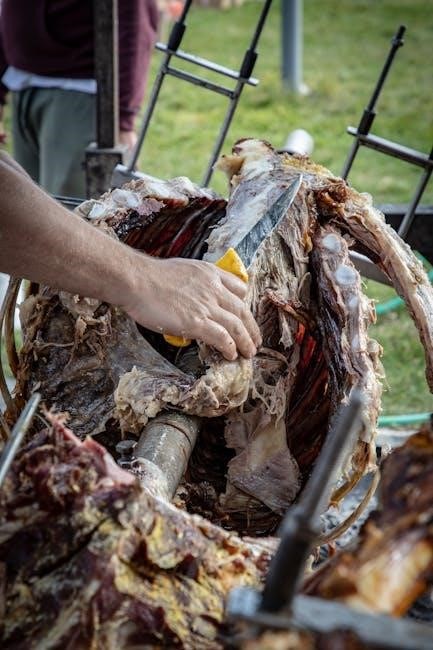
Common Beef Cuts and Their Uses
Popular beef cuts include ribeye for grilling‚ sirloin for versatility‚ and chuck roast for slow cooking. Ground beef is ideal for burgers and meatloaf‚ while brisket is perfect for barbecue.
Primal Cuts of Beef
Primal cuts of beef are the initial divisions of the carcass‚ forming the foundation for retail cuts. They include the chuck‚ rib‚ loin‚ round‚ flank‚ short plate‚ brisket‚ and shank. Each primal cut is taken from specific areas of the animal‚ such as the front or rear sections. The chuck‚ for example‚ comes from the shoulder and neck area‚ while the loin is sourced from the back. These primal cuts are further divided into retail cuts like steaks‚ roasts‚ and ground beef. Understanding primal cuts is essential for determining the quality‚ tenderness‚ and flavor of the final product. They guide how the beef is portioned and prepared for consumption‚ making them a critical step in the beef-cutting process.
Retail Cuts: Steaks‚ Roasts‚ and Ground Beef
Retail cuts of beef are the final products made from primal cuts‚ offering a variety of options for home cooking. Steaks‚ such as ribeye‚ sirloin‚ and filet mignon‚ are popular for their tenderness and rich flavor. Roasts‚ like chuck or round‚ are ideal for slow cooking‚ delivering hearty‚ flavorful meals. Ground beef is versatile‚ used in dishes like burgers‚ tacos‚ and meatloaf. Retail cuts are portioned to suit diverse preferences‚ with options for thickness‚ size‚ and fat content. Whether you prefer lean cuts or hearty‚ marbled steaks‚ retail cuts provide the flexibility to match your culinary needs and ensure a delicious dining experience.
Specialized Cuts for Slow Cooking
Specialized cuts for slow cooking are ideal for tender‚ flavorful dishes like stews‚ braises‚ and pot roasts. Cuts such as chuck roast‚ brisket‚ and short ribs are popular due to their rich connective tissue‚ which breaks down during cooking to create tender‚ juicy meat. These cuts are often less expensive but deliver exceptional flavor when cooked low and slow. Ground beef is also a versatile option for slow-cooked meals like chili or casseroles. Slow-cooking methods enhance the natural flavors of the meat‚ making these cuts perfect for hearty‚ comforting dishes. Proper portioning and selection ensure a delicious‚ satisfying meal tailored to your preferences.
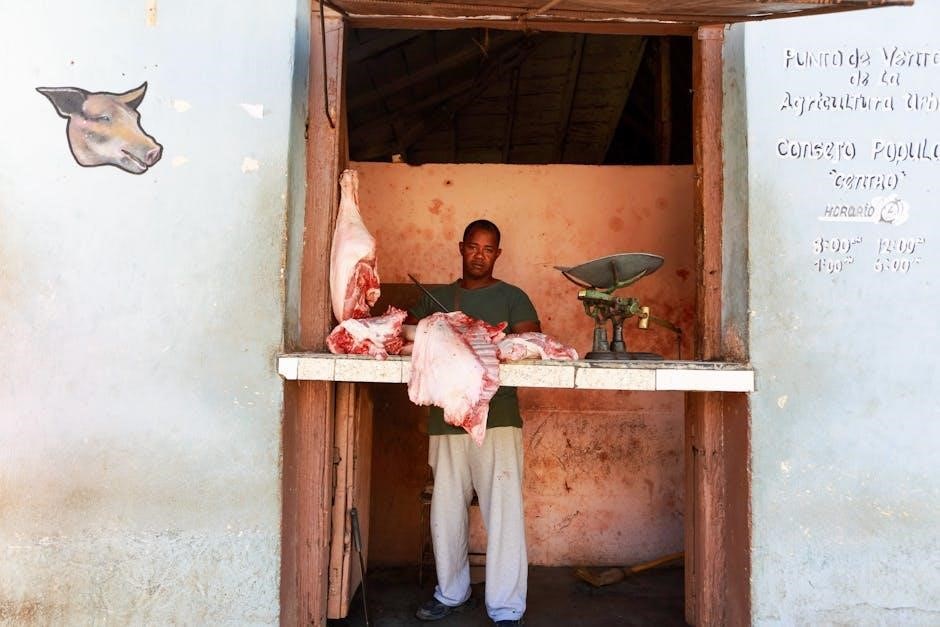
Step-by-Step Cutting Instructions
- Trim excess fat and connective tissue for even cooking.
- Slice primal cuts into uniform steaks or roasts.
- Dice tougher cuts for stews or ground beef.
- Portion according to desired serving sizes.
How to Cut a Whole Beef into Primals
Cutting a whole beef into primal cuts requires precision and knowledge of anatomical divisions. Start by separating the front and hind quarters using a meat saw‚ just above the hind leg joint. Next‚ remove the chuck primal from the front quarter by cutting along the natural seam between the ribs and shoulder. The rib primal is then isolated by cutting behind the 12th rib. Continue by separating the loin and flank sections from the hind quarter‚ ensuring clean‚ even cuts. Finally‚ the round primal is obtained by cutting below the loin. Each primal is then ready for further processing into retail cuts‚ ensuring efficiency and consistency in beef preparation.
Breaking Down Primals into Retail Cuts
Breaking down primal cuts into retail cuts involves precise trimming and cutting to achieve desired portions. For chuck primals‚ cut into shoulder roasts or steaks‚ ensuring even thickness. Rib primals are divided into ribeye steaks or roasts‚ while loin primals yield strip loin steaks or tenderloin. Round primals are typically cut into round steaks or roasts. Short ribs are trimmed from the chuck or rib sections‚ while soup bones are extracted from shanks. Brisket is separated from the belly and portioned into flats or points. Remaining trim is ground into beef‚ with options for lean or standard grind. Each cut is packaged according to size and preference‚ ensuring optimal flavor and texture in every portion.
Portioning Steaks and Roasts
Portioning steaks and roasts involves cutting primal sections into uniform sizes for cooking. Steaks are typically cut to 3/4-inch thickness for even cooking‚ with popular cuts like ribeye‚ sirloin‚ and T-bone. Roasts are portioned by size‚ such as 2-3 pound chuck or round roasts. Ground beef is packaged in 1-2 pound portions‚ while stew meat is cut into 1-inch cubes. Short ribs and soup bones are trimmed and packed separately. Brisket is divided into flats or points‚ and flank steak is often left whole or ground. Proper portioning ensures consistency and maximizes the versatility of each cut‚ catering to various cooking methods and preferences.
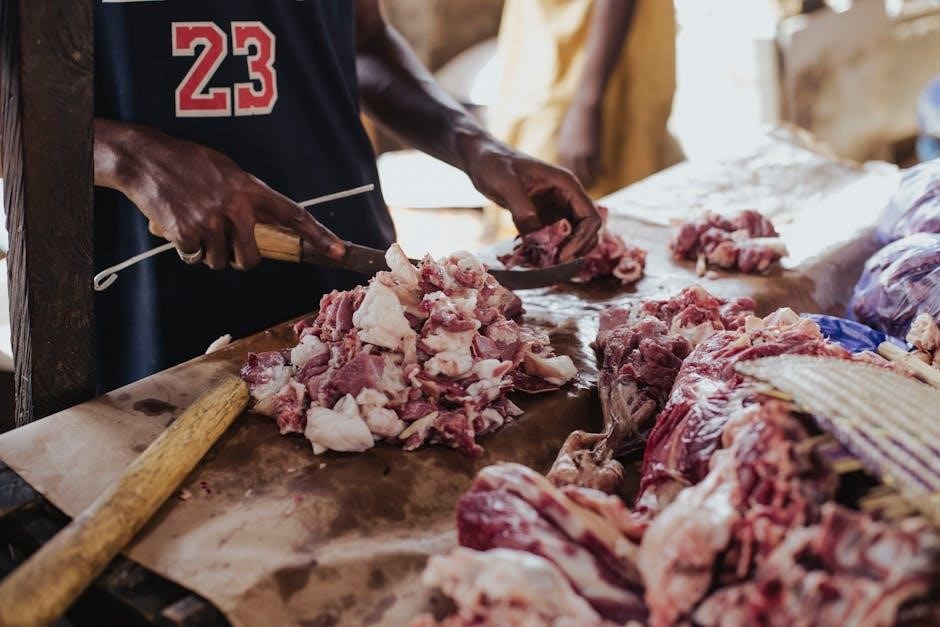
Handling and Storage of Beef
Proper handling and storage of beef ensure freshness and safety. Store beef in sealed containers at 32-40°F to prevent contamination. Freeze cuts at 0°F for longer preservation.
Proper Storage Techniques
Proper storage techniques are essential for maintaining the quality and safety of beef. Store beef in airtight‚ moisture-proof containers or vacuum-sealed bags to prevent contamination and spoilage. For fresh beef‚ keep it refrigerated at 32-40°F (0-4°C) and use within 3-5 days. For longer storage‚ freeze beef at 0°F (-18°C) or below; Label and date all packages to ensure proper rotation. Steaks and roasts can be frozen for 6-12 months‚ while ground beef is best used within 3-4 months. Avoid freezing beef in its original packaging; instead‚ rewrap it tightly to prevent freezer burn. Always thaw frozen beef in the refrigerator or cold water‚ never at room temperature‚ to maintain food safety.
Freezing and Thawing Guidelines
Freezing and thawing beef requires careful attention to maintain quality and safety. Beef should be frozen at 0°F (-18°C) or below‚ stored in airtight‚ moisture-proof packaging or vacuum-sealed bags to prevent freezer burn. Steaks and roasts can be frozen for 6-12 months‚ while ground beef is best used within 3-4 months. When thawing‚ place beef in the refrigerator or submerge in cold water‚ changing the water every 30 minutes. Never thaw at room temperature‚ as this can lead to bacterial growth. For quicker thawing‚ use cold water‚ ensuring the meat remains sealed to prevent contamination. Always label and date frozen packages for proper rotation and food safety.
Customizing Your Beef Order
Customizing your beef order involves specifying cuts like steaks‚ roasts‚ or ground beef‚ while opting for additions such as stew meat‚ bones‚ or specialized slow-cooking cuts.
Working with Your Butcher
Working with your butcher involves clear communication to ensure your beef is cut to your preferences. Butchers will ask detailed questions about your desired cuts‚ such as steaks‚ roasts‚ or ground beef‚ and specialized options like stew meat or slow-cooking cuts. They will also inquire about portion sizes‚ packaging preferences‚ and whether you want bones or organs included. Providing specific instructions ensures your order is tailored to your needs. Butchers may offer guidance to maximize the value of your beef‚ suggesting optimal cuts based on the animal’s characteristics. Clear communication is key to achieving the perfect balance of quality and customization in your beef order.
Filling Out a Beef Cut Sheet
Filling out a beef cut sheet requires careful consideration of how you want your beef processed. This sheet allows you to specify cuts such as steaks‚ roasts‚ or ground beef‚ as well as options like stew meat‚ bones‚ or organs. For example‚ you can choose to grind specific cuts or opt for bone-in or boneless selections. It’s important to provide clear instructions on portion sizes‚ packaging preferences‚ and any special requests. The cut sheet ensures your butcher understands your preferences‚ allowing them to tailor the beef to your needs. Taking the time to complete it accurately guarantees you receive exactly what you want from your beef order.
